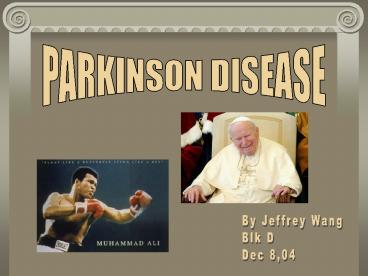PARKINSON DISEASE - PowerPoint PPT Presentation
1 / 12
Title:
PARKINSON DISEASE
Description:
... designer drugs, repeated head injuries sustained from boxing and brain tumors ... Caffeine consumers who consume 5 cups per day. Management ... – PowerPoint PPT presentation
Number of Views:65
Avg rating:3.0/5.0
Title: PARKINSON DISEASE
1
PARKINSON DISEASE
By Jeffrey Wang Blk D Dec 8,04
2
Content
- What Is Parkinson Disease?
- Symptoms
- Risk Factors
- Who Is at Risk?
- Management
- What Are Some Drug Treatments For Parkinson
Disease? - What Are Some Surgical Treatments For Parkinson
Disease? - Causes
- Glossary
- Bibliography
3
What Is Parkinson Disease
- It was first found in 1817 by James Parkinson
- A neurodegenerative progressive disease of the
nervous system which produces tremor, muscular
rigidity, as well as slowness and imprecision of
movements - Characterized by abnormalities of motor
function, several of which predominate, but all
do not necessarily occur in all individuals
4
Symptoms
- Physical Symptoms
- Hands tremble almost constantly when inactive
- Stooped, shuffling gait
- Bradykinesia (slowness of movement)
- Lack of facial expression
- Drooling
- Mental Symptoms
- Memory lost
- Dementia, in approximately 20 of all patients,
typically starting with slowing of thought and
progressing to difficulty organizing thoughts - Diminished sense of smell
5
Risk Factors
- Biggest risk factor is advancing age
- Family history is almost important
- Various poisons, drug side effect, designer
drugs, repeated head injuries sustained from
boxing and brain tumors - In most cases, the cause of the brain
degeneration is unknown - Cigarette smoking
- Caffeine consumption
6
Who Is at Risk
- Age 60s to70s
- Male have a slightly higher risk than female
- Sports players such as boxers have higher risks
than normal people - Smokers
- Caffeine consumers who consume 5 cups per day
7
Management
- Any exercise that gets your muscles moving your
heart pumping, and that you can keep up with it
every day such as walking, jogging, and swimming - Careful diet, no high protein food.
- Physical Therapy is important to many people
with Parkinson Disease - Visit your doctor regularly and join the support
groups
8
What Are Some Drug Treatment For Parkinson Disease
- There is no known cure, however, levodopa can
reduce Parkinson Disease from being worse. - But those drugs have unpleasant side effects
- There are five classes of drugs to treat the
physical symptoms of Parkinson Disease - Dopaminergic Agents
- COMT Inhibitors
- MAO-B Inhibitors
- Anticholinergics
- Amantadine
9
What Are Some Surgical Treatments
- Brain surgery is an option for advanced
Parkinson disease patients whose symptoms can no
longer be adequately managed with medications - Types of surgery are Lesion procedures, Deep
brain stimulation (DBS), and During needle-guided
(stereotaxic) brain surgery - New testing treatment called fetal issue
transplant operation
10
Causes
- Parkinson Disease is caused by premature aging
of deep- seated brain cells in an area called the
basal ganglia - Substantia nigra produce a chemical messenger
called dopamine. When 80 of dopamine is lost,
the symptoms of Parkinson's disease are produced.
- The majority cases of Parkinson Disease are due
to the potential interactions of genes and the
environment - Environmental causes are toxins such as
pesticides and herbicides
11
Glossary
- Neurodegenerative- the decrease in nerve system
- Bradykinesia slowness in movement and thoughts
- Dementia- a chronic or persistent disorder of
the mental processes marked by memory disorders,
personality changes, impaired reasoning, etc.,
due to brain disease or injury - Levodopa- a type of drug used to reduce symptoms
associated with Parkinson Disease - Substantia nigra- a midbrain structure which is
considered part of the basal ganglia complex due
to its close ties with the striatum - Dopamine- an important neurotransmitter
- Lesion procedures- deliver radio-frequency
energy to heat and destroy a pea-sized region
within the target, where there is abnormal
activity related to the movement problems - Deep brain stimulation (DBS)- uses implanted
electrodes to stimulate one or another of these
same regions - During needle-guided (stereotaxic) brain
surgery- the pathway to the target lies close to
several other important structures in the brain
that may be inadvertently stimulated during the
procedure. This may cause unusual sensations such
as flashing lights, tingling, or experience of
emotions - Fetal issue transplant operation- a surgical
treatment in which dopamine-producing fetal cells
are implanted in the brain.
12
Bibliography
- Encyclopedia
- Anne Hildyard. Parkinson Disease. Encyclopedia
of Health. Volume 11. ItalyMarshall Cavendish
Corporation, 2003. - David B. Jacoby, MD. Parkinson Disease.
Encyclopedia of Family Health. Volume10. Italy
Marshall Cavendish Corporation, 1998. - Angela Sheehan. Parkinson Disease. The
Marshall Cavendish Encyclopedia of Health. - Volume 10. Italy Marshall Cavendish
Corporation, 1995. - World Wide Web
- Somerset Pharmaceuticals, Inc. About
Parkinson Disease. Parkinsons Information.
1999. http//www.parkinsonsinfo.com/about_parkins
ons/ - Richard Robinson, Joy B. Leffler. Parkinson's
Disease Information for Patients and
Caregivers. WEMOVE. 7 December 2004.
http//www.wemove.org/par/































